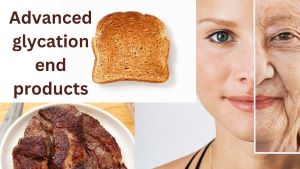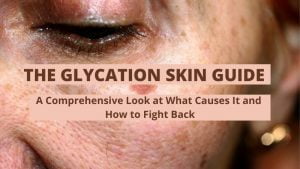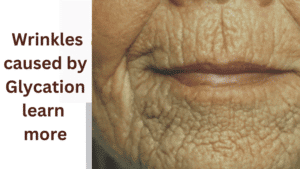
Advanced glycation end products
Advanced glycation end products (AGEs) are proteins or lipids that become glycated as a result of exposure to sugars. They are a bio-marker linked to aging and the development of many degenerative diseases, such as diabetes, atherosclerosis, chronic kidney disease, and Alzheimer’s disease. Reference
Glycation also presents in the skin as cross-hatched lines and wrinkles. You can tell normal wrinkles from glycated wrinkles. If you think of ‘normal’ wrinkles they are linear and generally parallel to each other in areas of facial movement. Lines created by Advanced glycation end products cross over each other and are often seen over the cheeks and around the chin.
Advanced glycation end products occur in food. A good example of this is brown toast. A chemical reaction occurs between amino acids (proteins) and carbohydrates (sugars), the macronutrients in bread, that cause it to brown, also referred to as the Maillard reaction.
Advanced glycation end products (AGEs) are substances formed in the late stage of the reaction between glucose and amino acids in proteins, nucleic acids or lipids. The French chemist Maillard first proposed this theory in 1912. Reference.
“Glycation is a nonenzymatic chemical reaction whereby sulfhydryl protein linkages are replaced by glucose, causing impairment in normal cellular and tissue functions.” Reference
“Glycosylation refers to an enzyme-mediated modification that alters protein function, for example, their life span or their interactions with other proteins (1). By contrast, glycation refers to a monosaccharide (usually glucose) attaching nonenzymatically to the amino group of a protein.” Reference.
Advanced glycation end products are naturally present in uncooked animal-derived foods, and cooking results in the formation of new AGEs within these foods. In particular, grilling, broiling, roasting, searing, and frying propagate and accelerate new AGE formation (7,13). Reference.
Foods highest in AGEs include meat (especially red meat), certain cheeses, fried eggs, butter, cream cheese, margarine, mayonnaise, oils, and nuts. Fried foods and highly processed products also contain high levels. Reference
However, only low molecular weight AGEs are absorbed through diet, and vegetarians have been found to have higher concentrations of overall AGEs compared to non-vegetarians.[4] Therefore, it is unclear whether dietary AGEs contribute to disease and aging, or whether only endogenous AGEs (those produced in the body) matter.[5] Reference.
I am not sure I agree with the above comment about vegetarians vs non vegetarians. Foods high in glycated end products include certain cheeses, fried eggs, butter, cream cheese, margarine, mayonnaise, oils, and nuts, all these are plentiful in a vegetarian diet.
Furthermore vegetarian’s often end up eating:
- Highly-refined grains and starches
- Processed meat substitutes made from soy, etc.
- Lots of sugar
These are high in AGEs.
Interestingly Wikipedia goes onto to say:
“This does not free diet from potentially negatively influencing AGE, but potentially implies that dietary AGE may deserve less attention than other aspects of diet that lead to elevated blood sugar levels and formation of AGEs.”
Contrary a more recent study to the Wikipedia reference in 2013 states “dietary advanced glycation end products (AGEs) are known to contribute to increased oxidant stress and inflammation.” Reference. Also another reference in 2021 “Dietary AGEs as Exogenous Boosters of Inflammation”, highlights that “the role of AGEs of dietary origin as a factor in human disease has been largely unappreciated.” Reference.
Endogenous substances and processes originate from within a living system. In contrast, exogenous substances and processes originate from outside of an organism.
AGEs can come from the body as well.
The formation of AGEs is a part of the normal consequence of metabolism. This is referred to as endogenous AGEs. However, this can cause disease if they accumulate in tissues and the circulation is high enough. Hyperglycaemia, hyperlipidaemia and increased oxidative stress (OS) can accelerate the formation of AGE. Reference
AGEs are bad news as far as health is concerned. They are not avoidable however you can reduce them. If you found this article interesting you may also be interested in the AGE Pill. For more information about glycation check out The Glycation Skin Guide.
Last Updated on March 27, 2023 by Katie Sisel Distributor


